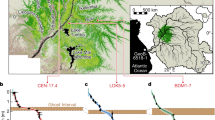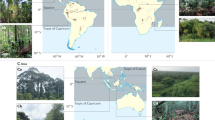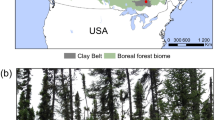Abstract
Tropical peatlands contain one of the largest pools of terrestrial organic carbon, amounting to about 89,000 teragrams1 (1 Tg is a billion kilograms). Approximately 65 per cent of this carbon store is in Indonesia, where extensive anthropogenic degradation in the form of deforestation, drainage and fire are converting it into a globally significant source of atmospheric carbon dioxide1,2,3. Here we quantify the annual export of fluvial organic carbon from both intact peat swamp forest and peat swamp forest subject to past anthropogenic disturbance. We find that the total fluvial organic carbon flux from disturbed peat swamp forest is about 50 per cent larger than that from intact peat swamp forest. By carbon-14 dating of dissolved organic carbon (which makes up over 91 per cent of total organic carbon), we find that leaching of dissolved organic carbon from intact peat swamp forest is derived mainly from recent primary production (plant growth). In contrast, dissolved organic carbon from disturbed peat swamp forest consists mostly of much older (centuries to millennia) carbon from deep within the peat column. When we include the fluvial carbon loss term, which is often ignored, in the peatland carbon budget, we find that it increases the estimate of total carbon lost from the disturbed peatlands in our study by 22 per cent. We further estimate that since 1990 peatland disturbance has resulted in a 32 per cent increase in fluvial organic carbon flux from southeast Asia—an increase that is more than half of the entire annual fluvial organic carbon flux from all European peatlands. Our findings emphasize the need to quantify fluvial carbon losses in order to improve estimates of the impact of deforestation and drainage on tropical peatland carbon balances.
This is a preview of subscription content, access via your institution
Access options
Subscribe to this journal
Receive 51 print issues and online access
$199.00 per year
only $3.90 per issue
Buy this article
- Purchase on Springer Link
- Instant access to full article PDF
Prices may be subject to local taxes which are calculated during checkout


Similar content being viewed by others
References
Page, S. E., Rieley, J. O. & Banks, C. J. Global and regional importance of the tropical peatland carbon pool. Glob. Change Biol. 17, 798–818 (2011)
Page, S. E. et al. The amount of carbon released from peat and forest fires in Indonesia during 1997. Nature 420, 61–65 (2002)
Hooijer, A. et al. Current and future CO2 emissions from drained peatlands in Southeast Asia. Biogeosciences 7, 1505–1514 (2010)
Gorham, E. Northern peatlands: role in the carbon cycle and probable responses to climatic warming. Ecol. Appl. 1, 182–195 (1991)
McDowell, W. H. & Likens, G. E. Origin, composition and flux of dissolved organic carbon in the Hubbard Brook valley. Ecol. Monogr. 58, 177–195 (1988)
Michalzik, B., Kalbitz, K., Park, J. H., Solinger, S. & Matzner, E. Fluxes and concentrations of dissolved organic carbon and nitrogen—a synthesis for temperate forests. Biogeochemistry 52, 173–205 (2001)
Mulholland, P. J. & Kuenzler, P. J. Organic carbon export from upland and forested wetland watersheds. Limnol. Oceanogr. 24, 960–966 (1979)
Page, S. E. et al. Ecological restoration of tropical peatlands in Southeast Asia. Ecosystems 12, 888–905 (2009)
Hoscilo, A., Page, S. E., Tansey, K. J. & Rieley, J. O. Effect of repeated fires on land-cover change on peatland in southern Central Kalimantan, Indonesia, from 1973 to 2005. Int. J. Wildland Fire 20, 578–588 (2011)
Limpens, J. et al. Peatlands and the carbon cycle: from local processes to global implications—a synthesis. Biogeosciences 5, 1475–1491 (2008)
Schiff, S. L. et al. Export of DOC from forested catchments on the Precambrian Shield of central Ontario: Clues from 13C and 14C. Biogeochemistry 36, 43–65 (1997)
Benner, R., Benitez-Nelson, B., Kaiser, K. & Amon, R. M. W. Export of young terrigenous dissolved organic carbon from rivers to the Arctic Ocean. Geophys. Res. Lett. 31, L05305 (2004)
Palmer, S. M. et al. Sources of organic and inorganic carbon in a headwater stream: evidence from carbon isotope studies. Biogeochemistry 52, 321–338 (2001)
Evans, C. D. et al. Evidence against recent climate-induced destabilisation of soil carbon from 14C analysis of riverine dissolved organic matter. Geophys. Res. Lett. 34, L07407 (2007)
Raymond, P. A. et al. Flux and age of dissolved organic carbon exported to the Arctic Ocean: a carbon isotopic study of the five largest arctic rivers. Glob. Biogeochem. Cycles 21, GB4011 (2007)
Miettinen, J. & Liew, S. C. Degradation and development of peatlands in peninsular Malaysia and in the islands of Sumatra and Borneo since 1990. Land Degrad. Dev. 21, 285–296 (2010)
Page, S. E. et al. A record of late Pleistocene and Holocene carbon accumulation and climate change from an equatorial peat bog (Kalimantan, Indonesia): implications for past, present and future carbon dynamics. J. Quat. Sci. 19, 625–635 (2004)
Hirano, T. et al. Carbon dioxide balance of a tropical peat swamp forest in Kalimantan, Indonesia. Glob. Change Biol. 13, 412–425 (2007)
Moore, S., Gauci, V., Evans, C. D. & Page, S. E. Fluvial organic carbon losses from a Bornean blackwater river. Biogeosciences 8, 901–909 (2011)
Montanarella, L., Jones, R. J. A. & Hiederer, R. The distribution of peatland in Europe. Mires Peat 1, 1–10 (2006)
Billett, M. F. et al. Carbon balance of UK peatlands: current state of knowledge and future research challenges. Clim. Res. 45, 13–29 (2010)
Nilsson, M. et al. Contemporary carbon accumulation in a boreal oligotrophic minerogenic mire - a significant sink after accounting for all C-fluxes. Glob. Change Biol. 14, 2317–2332 (2008)
Battin, T. J. et al. The boundless carbon cycle. Nature Geosci. 2, 598–600 (2009)
Cole, J. J. et al. Plumbing the global carbon cycle: Integrating inland waters into the terrestrial carbon budget. Ecosystems 10, 172–185 (2007)
Mayorga, E. et al. Young organic matter as a source of carbon dioxide outgassing from Amazonian rivers. Nature 436, 538–541 (2005)
Caraco, N., Bauer, J. E., Cole, J. J., Petsch, S. & Raymond, P. Millennial-aged organic carbon subsidies to a modern river food web. Ecology 91, 2385–2393 (2010)
Intergovernmental Panel on Climate Change (IPCC) Good Practice Guidance for Land Use, Land-Use Change and Forestry (LULUCF) (eds Penman, J. et al.) Sections 3.2, 3.5 (IPCC National Greenhouse Gas Inventories Programme, Technical Support Unit, 2003); http://www.ipcc-nggip.iges.or.jp/public/gpglulucf/gpglulucf_files/GPG_LULUCF_FULL.pdf
Murdiyarso, D., Hergoualc’h, K. & Verchot, L. V. Opportunities for reducing greenhouse gas emissions in tropical peatlands. Proc. Natl Acad. Sci. 107, 19655–19660 (2010)
Boehm, H.-D. V. & Siegert, F. Ecological impact of the one million hectare rice project in central Kalimantan, Indonesia using remote sensing and GIS. 22nd Asian Conf. Remote Sensing 1, 439–444, EME-08 (CRISP, 2001); http://www.crisp.nus.edu.sg/~acrs2001/pdf/126boehm.pdf
Page, S. E., Rieley, J. O., Shotyk, Ø. W. & Weiss, D. Interdependence of peat and vegetation in a tropical peat swamp forest. Phil. Trans. R. Soc. B 35, 1885–1897 (1999)
Takahashi, H., Usup, A., Hayasaka, H. & Limin, S. H. in Proceedings of the International Symposium on Land Management and Biodiversity in Southeast Asia, Bali, Indonesia, 17–20 September 2002 (eds Osaki, M. et al.) 311–314 (Hokkaido University and Indonesian Institute of Sciences, 2003)
Hope, D., Billett, M. F. & Cresser, M. S. A review of the export of carbon in river water: fluxes and processes. Environ. Pollut. 84, 301–324 (1994)
Vernimmen, R. R. E., Hooijer, A., Mamenun, E. A. & van Dijk, A. I. J. M. Evaluation and bias correction of satellite rainfall data for drought monitoring in Indonesia. Hydrol. Earth Syst. Sci. 16, 133–146 (2012)
Clark, D. B. et al. The Joint UK Land Environment Simulator (JULES), model description—Part 2: Carbon fluxes and vegetation dynamics. Geosci. Model Dev. 4, 701–722 (2011)
Best, M. J. et al. The Joint UK Land Environment Simulator (JULES), model description—Part 1: Energy and water fluxes. Geosci. Model Dev. 4, 677–699 (2011)
FAO/IIASA/ISRIC/ISS-CAS/JRC Harmonized World Soil Database (version 1.1) (Food and Agriculture Organisation and International Iinstitute for Applied Systems Analysis, 2009); http://webarchive.iiasa.ac.at/Research/LUC/External-World-soil-database/HTML/
Bruijnzeel, L. A. Hydrology of Moist Tropical Forests and Effects of Conversion: a State of Knowledge Review (UNESCO International Hydrological Programme, 1990); http://unesdoc.unesco.org/images/0009/000974/097405eo.pdf
Schellekens, J., Bruijnzeel, L. A., Scatena, F. N., Bink, N. J. & Holwerda, F. Evaporation from a tropical rain forest, Luquillo Experimental Forest, eastern Puerto Rico. Wat. Resour. Res. 36, 2183–2196 (2000)
Kume, T. et al. Ten-year evapotranspiration estimates in a Bornean tropical rainforest. Agric. For. Meteorol. 151, 1183–1192 (2011)
Komatsu, H., Cho, J., Matsumoto, K. & Otsuki, K. Simple modeling of the global variation in annual forest evapotranspiration. J. Hydrol. 420/421, 380–390 (2012)
Weedon, G. P. et al. Creation of the WATCH Forcing Data and its use to assess global and regional reference crop evaporation over land during the twentieth century. J. Hydrometeorol. 12, 823–848 (2011)
Hedin, L. O. et al. Patterns of nutrient loss from unpolluted, old-growth temperate forests—evaluation of biogeochemical theory. Ecology 76, 493–509 (1995)
Acknowledgements
S.M. was supported by a NERC PhD studentship (NE/F008813/1). Radiocarbon analyses were supported by the Natural Environment Research Council (NERC) and the Open University (CEPSAR) via the NERC Radiocarbon Facility (Environment), Allocations 1323.1008 and 15.91. A.J.W. was supported by the Joint DECC/Defra Met Office Hadley Centre Programme (GA01101). A. Hoscilo provided land-cover change estimates. We thank I. Mohammed, K. Kusin and L. Graham for field assistance. The Malaysian work was supported by the Royal Society and British Council and we thank P. Kuppan, N. Willis and F. Md. Yussof for field support.
Author information
Authors and Affiliations
Contributions
V.G., S.E.P. and C.D.E. conceived and led the research conducted in Kalimantan. S.M., V.G., S.E.P. and C.D.E. designed the study and S.M. performed all the Kalimantan field data collection and analysis. C.D.E. and M.H.G. coordinated, analysed and interpreted the radiocarbon component of the work. S.M., V.G. and S.E.P. performed the scaling-up calculations. C.F. conceived and led the Malaysian study, T.G.J. performed the field data collection and analysis, A.H. provided hydrological data and interpreted land surface information to allow catchment definition. A.J.W. provided modelled estimates of evapotranspiration. S.H.L. provided expertise on the history of land-cover change and field site selection. S.M., V.G., S.E.P. and C.D.E. led the writing of the paper. All authors discussed results and commented on the manuscript.
Corresponding author
Ethics declarations
Competing interests
The authors declare no competing financial interests.
Supplementary information
Supplementary Information
This file contains Supplementary Text, Supplementary Figures 1-4 and Supplementary References. Formatting of Equation S1 was corrected on 21 February 2013. (PDF 1475 kb)
PowerPoint slides
Rights and permissions
About this article
Cite this article
Moore, S., Evans, C., Page, S. et al. Deep instability of deforested tropical peatlands revealed by fluvial organic carbon fluxes. Nature 493, 660–663 (2013). https://doi.org/10.1038/nature11818
Received:
Accepted:
Published:
Issue Date:
DOI: https://doi.org/10.1038/nature11818
This article is cited by
-
Revealing the hidden carbon in forested wetland soils
Nature Communications (2024)
-
Degradation increases peat greenhouse gas emissions in undrained tropical peat swamp forests
Biogeochemistry (2024)
-
Landscape controls on riverine export of dissolved organic carbon from Great Britain
Biogeochemistry (2023)
-
Destabilization of carbon in tropical peatlands by enhanced weathering
Communications Earth & Environment (2022)
-
Targeted land management strategies could halve peatland fire occurrences in Central Kalimantan, Indonesia
Communications Earth & Environment (2022)
Comments
By submitting a comment you agree to abide by our Terms and Community Guidelines. If you find something abusive or that does not comply with our terms or guidelines please flag it as inappropriate.



